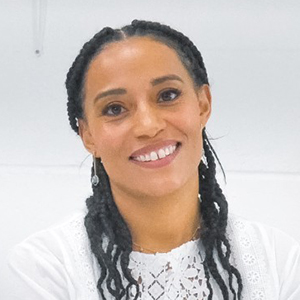
24 August 2023
In the first of three blog posts, Bernice Hewson shares key findings from her master’s dissertation, exploring how institutional whiteness in executive coaching serves to uphold racial hierarchies, while simultaneously seeking to challenge them. This introductory post examines why antiracism work is so challenging, how our good intentions can actually hinder progress, and what we need to do to initiate meaningful change. Also see the second and third blog posts.
As a coach and racial equity scholar, I have witnessed an increase in discussions on antiracism and racial equity within the coaching industry. Despite the heightened awareness, there remains a lack of understanding about what the industry can do to drive change. Antiracism work often focuses on what an institution ‘fails’ to do. However, I was curious to understand the active processes involved in coaching that uphold and reproduce racial inequalities. The focus of my research was to identify opportunities for meaningful change.
Why now?
In the last two years, we have witnessed a proliferation of corporate multiculturalism and antiracist discourse largely due to two things: Covid-19 and its disproportionate impact on ethnic minorities; and the murder of George Floyd, which sparked international protests. The coaching profession similarly formed part of this awakening to racial justice.
In September 2021, EMCC UK held the first professional body roundtable on ‘Racism in Coaching’, hosted by Coaching at Work. There was collective agreement among the professional coaching bodies that ‘we stand against racism’, and a recognition that it needs to be more than mere tokenism. There was a sense of collective strength and determination to examine how racial inequity manifests in coaching. However, my research suggests we currently lack the understanding, critical consciousness and education to properly conduct this exploration and initiate change. The question therefore remains, if the desire is there, where do we begin?
The research offers a timely and necessary intervention into the racial equity discourse within coaching, taking us on a personal and professional journey which invites critical reflection.
Reflective practice invitation
How does it feel to read this text?
Are there any aspects I feel uncomfortable about?
If so, how is this affecting my relationship to racial equity in coaching?
What don’t I understand that I want to make sense of?
Why is antiracism work so challenging?
Antiracism work calls on our intellectual and emotional labour to begin to understand how racism is omnipresent in our lives. Society positions racism as a binary, where the idea of a good person equals a non-racist and a bad person a racist. As a result, many of us cling on to the impossibility of ‘moral perfection’ with even the mere suggestion that we may contribute to racist processes and practices intolerable to hold. Conversations on race, racism and inequity are therefore often charged with fear, insecurity and confusion, often closing down the work before it has even begun.
The concept of moral perfectionism is a hangover of enlightenment thinking which also bestowed ideas of exceptionalism and individualism, that similarly function to obstruct progress towards racial equity. For example, when histories of race and racism are brought to the fore, we are urged to critique the past, positioning ourselves as superior, while looking back disapprovingly at our ancestors with disappointment, assuming we would have done better, or perhaps suggesting that it was a sign of the times. I urge us to resist this thinking and instead look inwards.
Antiracism work is a journey, and as with any journey of self-transformation, it is one that is non-linear, at times deeply uncomfortable, but also rehumanising. Investing in antiracism work requires you to give yourself permission to compassionately confront your biases. It is an invitation to welcome a level of discomfort and instability in the knowledge that it is only in this space that learning and transformation flourishes.
What can studying ‘whiteness’ teach us?
At the time of writing, there was an absence of coaching literature directly relating to antiracism through the lens of whiteness. According to Critical Whiteness Studies, whiteness is the underlying mechanism that maintains a racist system; not acknowledging it contributes to the permanence of race and racism (Matias, 2014).
The concept of whiteness in my research is not to be mistaken with whiteness as a social identity, located in white people. The focus in this study shifts to understanding how whiteness can materialise at a systems level, through institutional power that functions to reproduce and uphold racial inequalities. This is reflected in the choices we make and practices we employ – for example, the organisations we work with, the academic research we draw on, or the competencies we measure. Highlighting the dichotomy that coaching can, and is, reproducing racialised power structures while also simultaneously seeking to challenge them.
While institutional racism points to the failures of organisations and their inaction, the term institutional whiteness instead looks to see racism as form of doing, as a series of ongoing actions, decisions and practices that may be hidden, but serve to shape institutions over time. It is only through critical reflection and critical engagement that we become able to notice how discrimination and racism have been built into our working lives at both cultural and structural levels.
Gaining insight into the whitening practices present in coaching today offers a means of identifying meaningful antiracism activity in pursuit of racial equity.
The findings: Antiracist discourse in coaching paradoxically upholds whiteness
The concept that whiteness represents the norm, neutrality, an unmarked ‘thing’, is not new. The terminology of diversity and inclusion (D&I) nurtures this idea, with those racialised as non-white, representing diversity from the norm. Neoliberal, antiracist discourse tells society that all-white spaces are problematic, and as a result we have internalised the idea that racial diversity is a social good; assigning value to the inclusion of non-white individuals into social settings, workplaces, and coach training organisations.
My research exposes the misguided belief that the addition of black and brown bodies to all-white coaching spaces represents progress. While this is not unique to coaching, in some organisations it is becoming ‘the’ answer. While representation is important and necessary, this singular approach is flawed. Examining this as a solution, through the lens of institutional whiteness, reveals how whiteness functions by choosing to bring difference in and offer inclusion through the careful ‘management and containment of difference’ – for example, diversity KPIs, that serve to address the over-representation of whiteness in a coaching organisation.
As antiracism becomes mainstreamed and professionalised, the actions that we look to implement seem like common sense, but lack the critical thinking and knowledge required to disrupt racial inequalities. Instead they serve as a method of maintaining white dominance through the ‘performance’ of antiracism that fails to deliver meaningful change.
The diversity and inclusion discourse is further problematic because it highlights a collective failure to understand that black and brown bodies, socialised and educated in the same neoliberal framework, can also perpetuate systemic whiteness, through decisions, actions and practices that unwittingly uphold racial hierarchies.
It is institutional whiteness within the coaching institution that grants the power of action or inaction, inclusion or exclusion, change or the status quo.
So where do we go from here?
As coaches, mentors and supervisors, our knowledge gaps about racism, how it manifests and reproduces today in the workplace, mean that despite good intentions we are presently ill-equipped to change the system. The colourblind ideology identified in the Roche & Passmore (2021) research, highlight just how far we need to shift our understanding of race. While ‘race’ is a social construct (i.e. biologically not real), the impact of race is a very real lived reality, resulting in vast inequalities.
I believe there are many things coaching can do to turn the dial, and this research opens up new ways to think about racial equity and the efficacy of current antiracism activities within coaching.
If coaching is to fulfil the desire to ‘stand against racism’, we must first understand the problems we need to tackle. To make meaningful progress towards racial equity will require critically conscious leaders that value and understand the historical, political, social, and economic factors that continue to give ‘race’ meaning today. Only then will we be equipped to pierce the neoliberal discourse that prioritises diversity over change.
Reflective practice invitation
How does it feel to read this text?
Are there any aspects I feel uncomfortable about?
If so, how is this affecting my relationship to racial equity in coaching?
What don’t I understand that I want to make sense of?
Blog series
Bernice Hewson is sharing specific results from her research, exploring how the whitening practices present in the coaching industry serve to uphold racial hierarchies, while simultaneously seeking to challenge them, in a series of blog posts entitled: Hidden in plain sight: Institutional whiteness in executive coaching. The three posts in the series explore:
How antiracist discourse in coaching paradoxically upholds whiteness
How common sense, dissonance and innocence can maintaining racial inequity
How whiteness is implicit in our coaching curriculum and ways of knowing as coaches

About Bernice Hewson
Bernice Hewson is a racial equity scholar, anti-racism educator and founder of Raising Racial Consciousness Ltd. She works with coach training providers and leadership teams to influence and drive racial equity throughout their organisations. She is passionate about supporting individuals and teams that have made a conscious commitment to deepen their understanding of racial equity and inclusion, supporting them to learn and unlearn in a non-judgmental space as they learn to find their voice.
Bernice has a master’s degree in Culture, Diaspora and Ethnicity from Birkbeck University and is an accredited EMCC Senior Practitioner.
Suggested books
To understand performativity in anti-racism work: Ahmed, S., 2012. On Being Included: Racism and diversity in institutional life. 1st Edition ed. London: Duke University Press.
To understand whiteness: Garner, S., 2007. Whiteness: An introduction. 1st Edition ed. London & New York: Routledge.
To understand the important of critical reflection & critical consciousness in coaching: Thompson,N. & Thompson, S. 2018. The Critically Reflective Practitioner. 2nd Edition. Palgrave.
Bibliography
Ahmed, S., 2012. On Being Included: Racism and diversity in institutional life. 1st Edition ed. London: Duke University Press
Frakenberg, R., 1995. White women, Race matters: The Social construction of whiteness. In: Theories of race and racism. s.l. Routledge, pp. 517-533.
Hunter, S. & van der Westhuizen, C., 2021. Routledge Handbook of Critical Studies in Whiteness. 1st Edition ed. s.l. Taylor & Francis.
Matias, C. E. et al., 2014. ‘What is Critical Whiteness Doing in OUR Nice Field like Critical Race Theory?’ Equity & Excellence in Education, 47(3), pp. 289-304.
Passmore, J., 2021. Future Trends in Coaching: Executive Report 2021, Henley-On-Thames: Henley Business School and EMCC International.
Roche, C., 2021. Speak Up. Speak Out. The Ethics Matter Podcast. June: https://www.lifeflowbalance.co.uk/speak-up-speak-out-podcast/
Roche, C. & Passmore, J., 2022. ‘Anti-racism in coaching: a global call to action’. Coaching: An International Journal of Theory, Research and Practice, pp. 1-18.
Image by Parabol | The Agile Meeting Toolbox